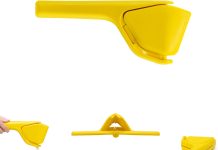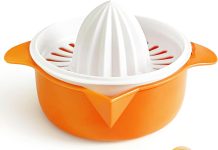Have you ever wondered if it’s safe to put ice cubes in a blender? We’ve all been there – craving an icy smoothie or frozen treat, only to hesitate and wonder if our trusty blender can handle the task. Well, you’ll be relieved to know that the answer is a resounding yes! In fact, blending ice cubes can be a game-changer when it comes to creating refreshing drinks and creamy desserts. So, let’s explore why and how ice cubes can ingeniously transform your blending experience, unlocking a whole new world of culinary delights.
Review contents
Can you put ice cubes in a blender?
Effects of Blending Ice Cubes
Blending ice cubes can have various effects, both in terms of the physical state of the ice and the final product you create. When ice cubes are blended, they are broken down into smaller pieces, resulting in a crushed ice texture. It can add a refreshing and icy element to your drinks or recipes, making them perfect for hot summer days or creating delicious frozen treats.
Types of Blenders that Can Blend Ice Cubes
Not all blenders are created equal when it comes to blending ice cubes. It is important to choose a blender that is specially designed to handle the task. High-powered blenders with strong motors and sharp blades are the best option for blending ice cubes. These blenders are specifically built to crush through the ice without any strain or damage to the blades or motor. Look for blenders with a minimum power of 1000 watts and stainless steel blades for optimal ice crushing performance.
Preparation of Ice Cubes
Before blending ice cubes, it is essential to prepare them correctly to ensure the best results. Start by making sure your ice cubes are clean and free from any impurities or unwanted flavors. If you are using ice cubes from a tray, make sure to transfer them into a clean and freezer-safe container. It is also a good idea to avoid using ice cubes that have been sitting in the freezer for an extended period, as they may have absorbed odors from other food items. Freshly made ice cubes will result in a cleaner and more refreshing taste in your blended creations.
Safety Measures When Blending Ice Cubes
Blending ice cubes can be a straightforward and safe process if the necessary safety measures are followed. To ensure your safety and the longevity of your blender, it is crucial to avoid overloading the blending jar with too many ice cubes at once. This can strain the blender’s motor and potentially cause damage. It is also important to always secure the lid tightly before blending to prevent any splattering or spillage. Lastly, never insert any objects into the blender while it is running, as this can lead to accidents or damage to the appliance.
Blending Techniques for Ice Cubes
To achieve the perfect blend with your ice cubes, it is essential to follow proper blending techniques. Start by adding a small amount of liquid, such as water or juice, to the blender jar before adding the ice cubes. This will help create a sufficient liquid base for the blending process. Gradually add a few ice cubes at a time, pulsing the blender on low-speed settings until the desired consistency is reached. Avoid continuously running the blender on high-speed settings, as this can cause the ice cubes to melt too quickly and create a watery mixture.
Recipes Involving Blending Ice Cubes
Blending ice cubes opens up a world of delicious recipe possibilities. One popular option is to create refreshing fruit smoothies by blending ice cubes with a variety of fresh fruits, yogurt, and a touch of honey or sweetener. You can also make indulgent frozen margaritas or daiquiris by blending ice cubes with your choice of alcohol and fruity mixers. For those with a sweet tooth, blending ice cubes with milk, sugar, and your favorite flavoring can result in creamy and flavorful milkshakes. The possibilities are endless when it comes to incorporating blended ice cubes into your culinary repertoire.
Benefits of Blending Ice Cubes
The benefits of blending ice cubes extend beyond just adding a cool and icy element to your drinks and recipes. Blending ice cubes can help to quickly chill down beverages, making them enjoyable even on the hottest days. It also adds a delightful texture and crunch to smoothies, making them more satisfying and interesting to consume. Blending ice cubes with fruits or other ingredients can also help to intensify flavors and create a more well-rounded taste experience. Additionally, blended ice cubes can be used as a base for homemade popsicles or as a decorative element in dessert presentations.
Common Issues When Blending Ice Cubes
While blending ice cubes can bring forth delightful results, there are common issues that may arise during the process. One common problem is the formation of large ice chunks that resist the blending blades. To prevent this, it is important to ensure that the ice cubes are all roughly the same size and not stuck together. Another issue that can occur is the blender’s motor overheating due to excessive blending without breaks. To avoid this, it is best to blend in small batches and give the motor time to cool down between blends. Lastly, improper blending techniques can result in a mixture that is either too icy or too watery. Experimenting with different blending methods and ratios can help overcome these issues and achieve the desired consistency.
Alternative Methods for Crushing Ice Cubes
If you do not have a blender suitable for crushing ice cubes or prefer not to use one, there are alternative methods for crushing ice cubes. One common method is using a manual ice crusher or mallet to crush the ice cubes by hand. Another option is placing the ice cubes in a thick plastic bag and using a rolling pin or a heavy object to crush them. These methods require more physical effort but can be effective for small quantities of ice cubes. Alternatively, some refrigerator models come with a built-in ice crushing feature, which eliminates the need for a separate blender or crushing tool.
Conclusion
In conclusion, blending ice cubes can add a refreshing and icy element to your drinks and recipes. With the right blender, proper preparation and safety measures, and the use of appropriate blending techniques, ice cubes can be effectively crushed without causing damage to the blender or compromising the quality of the final product. The benefits of blending ice cubes range from enhancing flavors to creating visually appealing presentations. However, it is important to be aware of common issues that may arise and explore alternative methods if a blender is not available. So go ahead, experiment with blending ice cubes, and enjoy the icy delights it brings to your culinary creations.



































